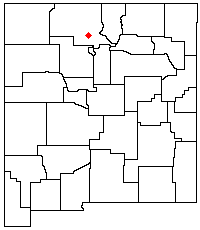 |
| www.un |
Witches and Politics Interwoven in New Mexico
Book filled with political, historical, and spiritual intrigue regarding the last witch trials in North America
by Raymundo Eli Rojas
Share
The witchcraft outbreaks in Abiquiu, New Mexico between 1756 and 1766 caused the last witch trails that would occur in North America.
Only 50 years after the Salem Witchcraft Trials, would this event in Abuqui have the same results?
Show trials. Hangings. Pressing of accused to death. Dozens filling the jails.
The Witches of Abiquiu: The Governor, the Priest, the Genízaro Indians, and the Devil (University of New Mexico Press) describes the events within Abiquiu, a Northern New Mexico Pueblo settlement.
Filled with religious infighting, political intrigue, curses and hexes, this book, though a work of nonfiction, reads like a fiction thriller at times. It fills the readers with suspense and makes the readers wonder: Is the Devil really at work?
Any fan of the Salem Witch Trials will love The Witches of Abiquiu.
Any fan of the Salem Witch Trials will love The Witches of Abiquiu.
Abiquiu was at the time in the southern part of the Spanish settlements in Northern New Mexico. It served as bulwark against Apaches raids. Governor Velez Cachupin gave a land grant to the Ganizaros in the hopes the lands would serve as a buffer zone against the nomadic tribes.
Those who received the land grant were in a buffer zone themselves. They were not Spanish and they were not what you would call the traditional “Pueblo” Indians: Genizaros. The pueblo consisted of Indians of mixed derivation, former servants, many non-Pueblo Indians including plains tribes, Hopis, and others who had no Pueblo community of their own.
The definition of Genizaros was never quite set in stone and according to authors Malcolm Ebright and Rick Hendricks, this factor plays a part in the witchcraft controversy.
If you think modern New Mexican politics is scandal-laden and filled with negative campaigning, in Spanish colonial times, transfers of power from one Spanish governor to another was usually laden with scandal.
Former and new governors would try to slander each other. The book gives the examples of letters written by the governor, the Franciscan order, the Catholic diocese, and rival diocese down south. These letters, sent behind each other's backs, were meant to poison the well with Spanish and church authorities.
 |
| The adobe St. Thomas Church in Abiquiú |
When the local priest files a charge that he has been bewitched, what is uncovered is a web of blame and indictment. Is the Devil really at work? Are sorcerers at work in the night? Are Satanic rituals being performed at local indigenous religious sites? Who is really a witch? Are they just healers and curanderos? Should the Spanish Inquisition investigate? Will this have the same results as Salem, Massachusetts and the paranoia that occurred there? Is the witchcraft outbreak a response to the banning of indigenous religious rituals the Spanish authorities and Catholics church outlawed?
The Witches of Abiquiu is both a good historical read and thriller as it shows how politics and witchcraft, are sometimes interwoven.







No comments:
Post a Comment